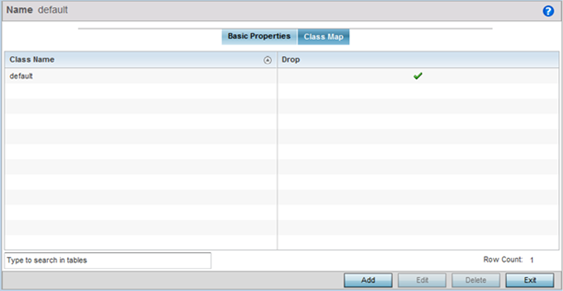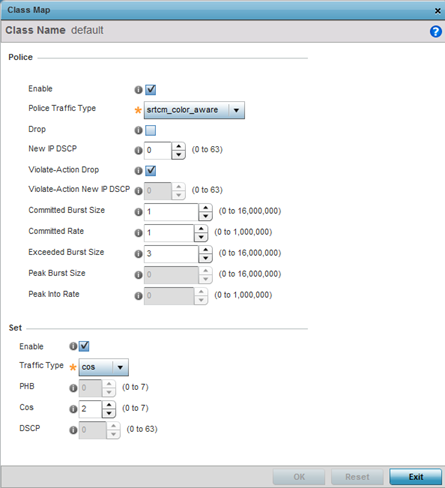Configuring EX3500 QoS Policy Map
About this task
An EX3500 switch can have its own WiNG defined policy map that can be attached to an interface to specify a QoS service policy. Use a QoS policy map to assign priority to mission critical EX3500 switch data traffic, prevent EX3500 switch bandwidth congestion and prevent packet drops. To review existing EX3500 QoS policy map configurations and assess whether new ones require creation, modification or deletion:
Procedure
-
Select Configuration → Network → EX3500 QoS Policy Map.


-
Select Add to create a
new EX3500 QoS policy map, or select an existing policy
and Edit
to modify its attributes. Obsolete policy maps can be selected and Deleted as
needed. Copy to duplicate an existing policy map or Rename them as
needed.


- If adding a new EX3500 QoS policy map, enter a 32 character maximum Name to help differentiate this policy from others with similar attributes.
- Enter a 64 character maximum Description to help differentiate this policy‘s EX3500 traffic prioritization scheme.
- Select OK to save the changes. Select Reset to revert to the last saved configuration.
-
Select the Class Map tab.
Existing class map configurations display along with their drop designations defining whether packets will be dropped if exceeding the actions set for this class map configuration.


-
Select Add to create a
new EX3500 QoS class map, or select an existing class
name and
Edit to modify its attributes. Obsolete class maps can be
selected and Deleted as needed.


-
Set the following class map
Police
actions to apply traffic restrictions and packet drop criteria to EX3500 switch data traffic:
Enable Enable this option to apply traffic type classification restrictions and packet drop criteria to EX3500 switch data traffic. This option is dialed by default. Police Traffic Type Use the drop-down menu to specify the EX3500 switch traffic type to drop when the specified violation criteria is exceeded. A policing scheme can be applied before writing packets to the TX port by dropping or changing the color (green, yellow or red) of the packet in a static manner, depending on both the input and output colors of the packets. Options include flow, srtcm_color_aware, srtcm_color_blind, trtcm_color_aware and trtcm_color_blind. Drop Select this option to drop EX3500 switch packets when the violation action criteria has been exceeded. This option is not available when flow is selected as Police Action Type. New IP DSCP Use the spinner control to set a DSCP value (from 0 - 63) as required by an exceeded action criteria. DSCP is the Differentiated Services Code Point field in an IP header for packet classification. Packets are filtered based on the traffic class defined in the IP DSCP field. This option is not available when flow is selected as the Police Action Type or when Drop is enabled. Violate-Action Drop Select this option to drop packets when the specified traffic type classification restrictions and packet drop criteria are exceeded. When enabled (default setting), the Violate Action New IP DSCP setting is disabled. Violate-Action New IP DSCP If the Violate-Action Drop option is disabled, set a DSCP value (from 0 - 63) as required by an exceeded action criteria. Committed Burst Size Set a committed (maximum) burst size between 0 - 16,000,000. The smaller the burst, the less likely received EX3500 switch packets result in data traffic congestion. Committed Rate Set the CIR (committed information rate) from 0 - 1,000,000 for EX3500 switch data traffic. The CIR is a bandwidth (expressed in bits per second) allocated to the connection with the EX3500 switch. This form of rate limiting reduces the maximum rate sent or received, and prevents any single EX3500 switch from overwhelming the WiNG managed network. Exceeded Burst Size When srtcm_color_aware or srtcm_color_blind are selected as the Police Traffic Type, set an excess burst size (from 0 - 16,000,000 bytes). The excess busrt size allows for periods of bursting traffic exceeding both the CIR and committed burst size. Peak Burst Size When trtcm_color_aware or trtcm_color_blind are selected as the Police Traffic Type, set a Peak Burst Size (from 0 - 16,000,000 bytes). The Peak Burst Size defines the maximum number of bytes of unused peak bandwidth capacity that can be accumulated. The accumulated bandwidth allows for periods of bursting traffic exceeding the Peak Info Rate and Committed Burst Size. Peak Info Rate When trtcm_color_aware or trtcm_color_blind are selected as the Police Traffic Type, set a Peak Info Rate (from 0 - 1,000,000 kilobytes per second). The Peak Info Rate is the maximum rate for traffic arriving or departing the interface under peak conditions. Traffic exceeding the committed information rate (CIR) and the committed burst size is metered to the Peak Info Rate. -
Refer to the Set field to
define the EX3500‘s traffic type and set its
behavior.
Enable Select enable to refine the EX3500‘s traffic type to either PHB, COS or DSCP. Traffice Type Use the drop-down menu to specify the EX3500 switch traffic type. Options include phb, cos and DSCP. Once an option is selected, refine that traffic type‘s behavior. PHB When PHB is selected as the Traffic Type, set the per-hop behavior value (from 1 - 7) applied to matching packets. The PHB defines the policy and priority applied to a packet when traversing a hop. PHBs are created (one for each combination of the top 3 bits) as bbb000 to match precedence behaviors and leaves other DSCP values open, where each b may take the value zero or 1. Cos When Cos is selected as the Traffic Type, assign a 802.1p priority (0 - 7) as a 3-bit IP precedence value of the IP header used to set the EX3500 switch user priority. The valid values for this field are 0 – Best Effort, 1 – Background, 2 – Spare, 3 – Excellent Effort, 4 – Controlled Load, 5 – Video, 6 – Voice, 7 – Network Control. DSCP When DSCP is selected as the Traffic Type, set a DSCP value (from 0 - 63). DSCP is the Differentiated Services Code Point field in an IP header for EX3500 switch packet classification. Packets are filtered based on the traffic class defined in the IP DSCP field. - Select OK to save the changes. Select Reset to revert to the last saved configuration.
